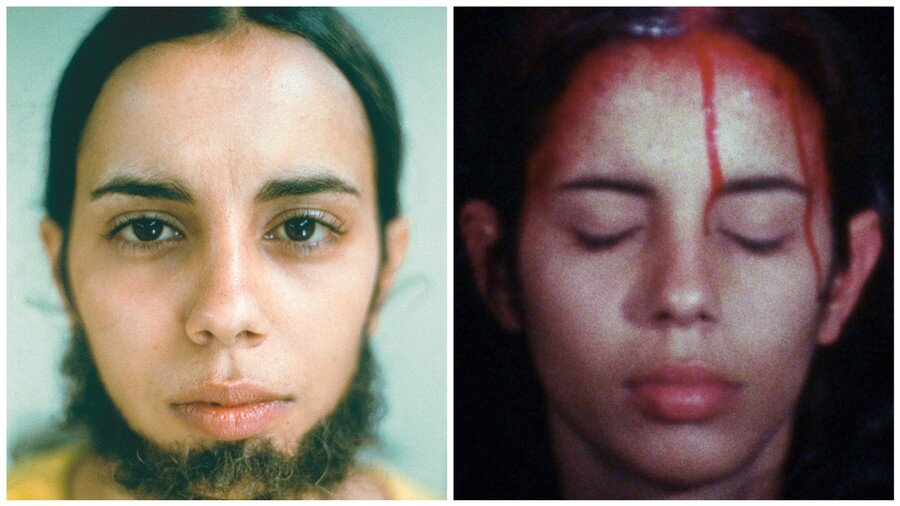Portrait of Ana Mendieta © The Estate of Ana Mendieta Collection, LLC.
By Julian Lucas
Thinking about feminism, during the ’70s, we can all thank Judy Chicago, who pioneered one of the first feminist classes at Fresno State University in 1970. Linda Nochlin wrote a book entitled, “Why have there been no great women Artists”. During this era women began to use their bodies, not as an object but as a subject in regards to the body art.
It has been 30 years since the untimely death and murder trial of her husband, artist Carl Andre. Mendieta gambled by intertwining art and life experiences with her experimental practices of short film and other types of media during an era short films were not a part of the art world. Mendieta's works were powerful, always feminist and real. Ana Mendieta is best known for what she defines as "earth-body works," and her practice is based on women's body themes, mortality, ethnic displacement, and conversion. Mendieta integrated natural elements within her performances, which included blood, soil, water, and fire. While her works can be viewed as autobiographical, in her film and photographic work of the entanglement of landscape and the body is often associated with land art and allowed her work to transgress the limits of personal experience to express universal modes of conversion.
L: ANA MENDIETA, LA VIVIFICACIÓN DE LA CARNE: EL LABERINTO DE VENUS SERIES, 1982 (ESTATE PRINT 1994). [THE VIVIFICATION OF THE FLESH: LABYRINTH OF VENUS SERIES], ESTATE BLACK AND WHITE PHOTOGRAPH, 52.5 X 39.75 INCHES (133.4 X 99.1 CM), EDITION OF 6. R: ANA MENDIETA, GUANAROCA (ESCULTURAS RUPESTRES), 1981. (ESTATE PRINT 1994) [FIRST WOMAN (RUPESTRIAN SCULPTURES)], LIFETIME BLACK AND WHITE PHOTOGRAPH, 53.5 X 39.25 INCHES (135.9 X 99.7 CM). © THE ESTATE OF ANA MENDIETA COLLECTION
In 1961, after Fidel Castro came to power, Ana Mendieta and her older sister, Raquelin, were sent to America. At only 12 and 14 years of age, the girls were on their own when their mother and younger brother arrived in the United States five years later. While residing in the United States, Ana felt disconnected from her reality. After leaving her homeland of Cuba she began to question her cultural identity to which she became more in tune with being a woman of color.
Untitled (Glass on Body Imprints), Photographed in 1972 and printed in 1997
© THE ESTATE OF ANA MENDIETA COLLECTION, LLC
Although her work can be seen as autobiographical, Mendieta has turned tension, agony, and resentment into powerful, intriguing, and stimulating practices of gender, sexuality, violence, death, place, and belonging. Using her body as a vessel of flesh, bone, and blood, she participated in performing arts, body art, and land art to create a raw, vibrant thought-provoking work, that conveyed the values of her native land and questioned society's treatment of women.
Julian Lucas, is fine art photographer, photojournalist, and creative strategist. Julian also works as a housing specialist which, includes linking homeless veterans to housing. Julian has lived in Chicago, Inglewood, Portland, and the suburbs of Los Angeles County including Pomona.


![L: ANA MENDIETA, LA VIVIFICACIÓN DE LA CARNE: EL LABERINTO DE VENUS SERIES, 1982 (ESTATE PRINT 1994). [THE VIVIFICATION OF THE FLESH: LABYRINTH OF VENUS SERIES], ESTATE BLACK AND WHITE PHOTOGRAPH, 52.5 X 39.75 INCHES (133.4 X 99.1 CM), EDITION OF 6.…](https://images.squarespace-cdn.com/content/v1/5b824b4a12b13f922e98352f/1605686739447-U3XGXFCQK8GFN57Z80YO/1524847687849-AnaMendieta3.jpeg)







